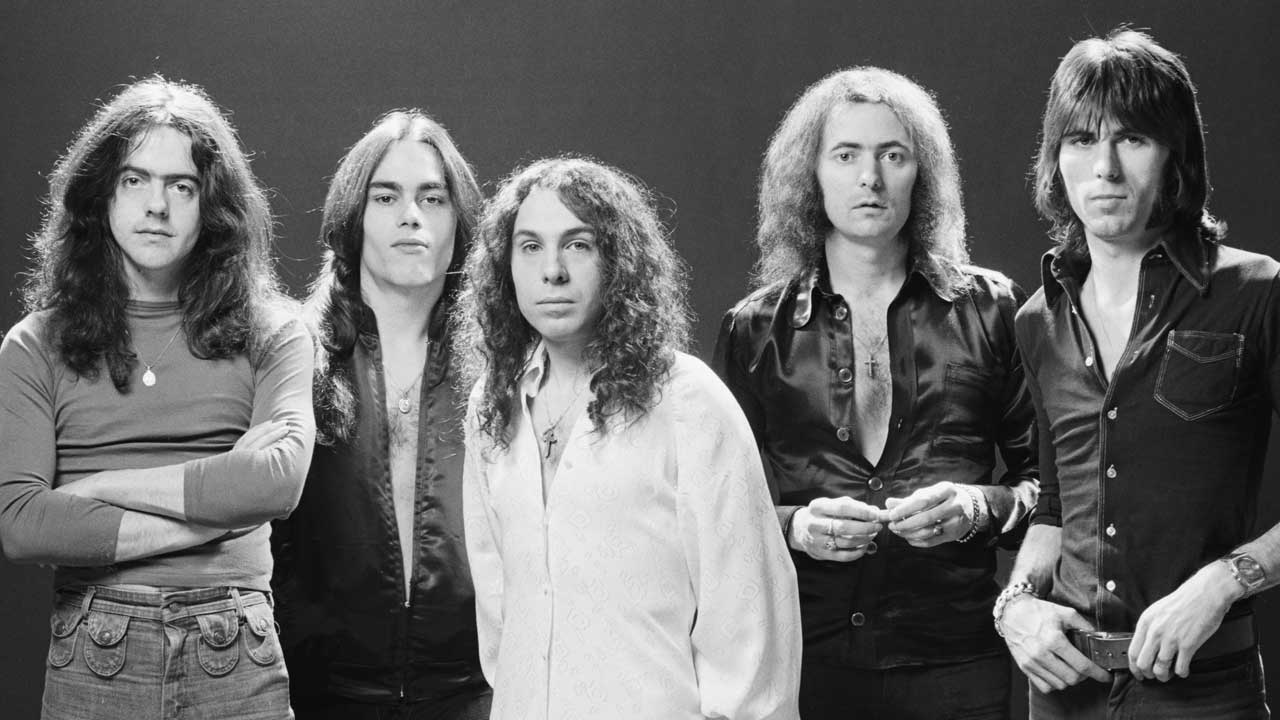What began as a solo project by guitar god Ritchie Blackmore while he was still a member of Deep Purple, grew into eight studio albums by a band that occupied The Man In Black’s time after he quit Purple following Stormbringer in 1975, until their comeback with Perfect Strangers in 1984.
On record, Rainbow’s greatest claim to fame – perhaps even above other-worldly guitar playing – was to properly launch the career of Ronnie James Dio. The singer made only three Rainbow studio albums and once he was sacked the band quickly abandoned his sword-and-sorcery stylings to seek chart success.
That came with the fourth record, on which Graham Bonnet sang, but he was soon replaced by Joe Lynn Turner as Blackmore set his sights on emanating Foreigner. (“They write incredible songs and I am influenced by their singer. It’s my type of music…” he told Pete Makowski in July 1981.)
Rainbow never made two studio albums with the same line-up because, as Blackmore admits, he grew tired of member when they wanted more money, more limelight, or both.
Often thinking of himself as a mere “riff merchant”, Blackmore constantly sought songwriters. Delivering on this front were his ex-Purple bandmate Roger Glover (also serving as Rainbow’s producer and bassist) and Turner, who served on four and three albums, respectively. The catalogue is a mixed bag – and to complicate matters there’s an eighth studio album made 12 years after Rainbow initially folded, with yet another new line-up.

8. Straight Between The Eyes (1982)
You can trust Louder Our experienced team has worked for some of the biggest brands in music. From testing headphones to reviewing albums, our experts aim to create reviews you can trust. Find out more about how we review.
It does have one really good song on it – the single Stone Cold (top 40 on both sides of the Atlantic) – but everything else suggests the band were devoid of fresh ideas.
Bring On The Night (Dream Chaser) re-uses part of the Gates Of Babylon chorus; Tite Squeeze re-works the riff to another earlier Rainbow album track The Shed (Subtle); Tearing Out My Heart plays like a new version of Purple’s Mistreated; and Eyes Of Fire misfires badly as it steals a bit of everything Rainbow had ever succeeded with before, but omits craft. Death Alley Driver and Power were written to be played live but aren’t great studio cuts.
7. Bent Out Of Shape (1983)
The longer Rainbow went on, the harder it became to make a case for them. Come their seventh album (the last of their initial run), Blackmore was the only constant member and saw nothing weird about including a reworking of Howard Blake’s theme to the animated children’s film Snowman.
Only Firedance, Drinking With The Devil and the instrumental Anybody There played to fans of the original Rainbow. The singles Street Of Dreams (peaking at 52 in the UK and 60 in the USA) and Can’t Let You Go proved the AOR direction had some merit – even if the target was usually missed. Keyboard player Dave Rosenthal and drummer Chuck Burgi were last seen touring together in Billy Joel’s band.
6. Stranger In Us All (1995)
Made after Blackmore had quit Deep Purple for the final time, this (like Rainbow’s first) was intended as a solo record but the label BMG insisted it be billed under the band’s name. The singer was Doogie White – whose strong and versatile voice has echoes of both Dio and Turner. White co-wrote most of the material with Blackmore who plays as if reinvigorated by songs close in style to Rainbow’s 1975 debut.
Hunting Humans (Insatiable) is strongest, but the haunting Ariel and the rock arrangement of Grieg’s Hall Of The Mountain King are also of superior quality. As the short-lived Ronnie Romero-fronted “Rainbow” of 2016 only played live, this remains the last rock album of Blackmore’s career – before he shifted direction entirely to Blackmore’s Night alongside (his now wife) Candice Night, who also features here.
5. Difficult To Cure (1981)
The follow-up to 1979’s hit album Down To Earth was conceived as a second outing for Graham Bonnet – but he was sacked after the backing tracks had been recorded. So instead it became the first to feature Joe Lynn Turner – and also drummer Bobby Rondinelli (replacing Cozy Powell, who joined the Michael Schenker Group). Many fans suggest the arrival of these two Americans (particularly the singer) saw Rainbow sacrifice their heritage in search of the US market – but it stalled at 50 on the Billboard chart.
Arguably, it fared better in the UK by spawning two hits: a cover of Russ Ballard’s I Surrender – which rose to number 3 and the Blackmore-Glover original Can’t Happen Here. Elsewhere, long-term fans enjoyed the guitar fireworks on the Jeff Beck-like instrumental Vielleicht Das Nächste Mal (Maybe Next Time), Spotlight Kid and the Hendrix-influenced blues of Midtown Tunnel Vision.
4. Long Live Rock’n’Roll (1978)
The third album of the Rainbow catalogue, the last to feature Ronnie James Dio, is a divisive one. It’s not really a patch on either of its predecessors but it does feature Dio – and a scalding opening rocker in Kill The King, the near seven-minute epic Gates Of Babylon (a close relative of and worthy rival to Led Zeppelin’s Kashmir) plus the unexpectedly good-time slant of the title-track.
LA Connection was a half-decent top 40 single in the UK, but The Shed (Subtle) is very poor. Dio aficionados always point to his superb singing on Rainbow Eyes, but others see that song as an atypical and over-long ballad whose main redeeming feature is its position at the end of the album because that makes it easier to skip.
3. Down To Earth (1979)
No one really knew what to expect after Dio’s departure. But it wasn’t a hit single written by Russ Ballard called Since You’ve Been Gone. Nor was it a second hit, All Night Long (derided as sexist, even then) – much less Rainbow on Top Of The Pops with a singer (Graham Bonnet) sporting a Hawaiian shirt and a Beach Boys haircut.
Rainbow had “gone mainstream” but did so at a time when the pre-MTV charts were open to rock acts muscling in. Alongside the singles, Down To Earth delivered heavyweight counterpoints, not least the standout epic Eyes Of The World, the blues of Love’s No Friend and the frantic closer Lost In Hollywood, that connected the new Rainbow to the Dio era even as the funkier groove of Makin’ Love pointed elsewhere.
2. Ritchie Blackmore’s Rainbow (1975)
Rainbow’s debut album began as an experiment for Blackmore, then touring in Florida with Purple, for which he hired their support band Elf (mainly for their singer Dio) to record a cover of Black Sheep Of The Family, then Sixteenth Century Greensleeves, for a potential single solo release.
The guitarist’s respect for and rapport with the singer was instant and soon an album containing classics-to-be Man On The Silver Mountain (much loved by John Bonham), Catch The Rainbow, Temple Of The King and a hard-rocking instrumental cover of The Yardbirds’ Still I’m Sad emerged – along with Blackmore’s resignation from Purple. The rest of Elf didn’t macth the pedigree of Dio and Blackmore, and Martin Birch’s production is a little flat, but Rainbow never again delivered as many great songs on one album.
1. Rainbow Rising (1976)
Second album Rainbow Rising contains just six songs and runs less than 35 minutes, but is indisputably the jewel in the band’s crown. A year after the debut, Rainbow were much improved by the arrival of Cozy Powell on thunderous drums alongside Jimmy Bain on bass. More importantly, Blackmore and Dio were on a creative hot streak that gave power even to three tracks overshadowed the highlights. The first of these highlights opens the album with a swirling keyboard introduction (played by the other new recruit, Tony Carey) then grows dramatically into the riff-driven mysticism of Tarot Woman.
The fantasy stylings approach perfection, though, on side two. There, the pairing of two eight-and-a-half minutes epics Stargazer and Light In The Black – lyrically linked but stylistically very different – takes Rainbow to heights seldom matched by any other hard rock/power metal band since. And both songs feature guitar solos among Blackmore’s finest. The first (complete with swirling riff and orchestral backing) tells of a wizard who for nine years enslaves devotees to build a tower of stone from which he will fly; the second is a fast-and-furious reaction to the lie of the wizard’s failure. Together they are sublime. Rainbow at their very best.

